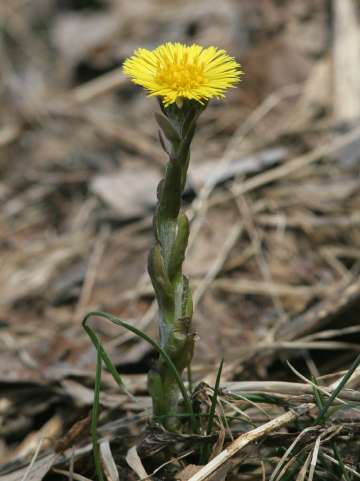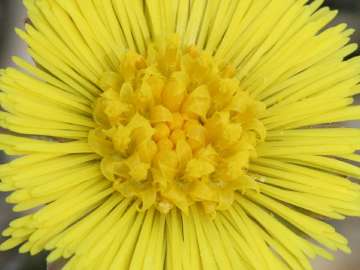

PHOTO COURTESY OF GARRY KESSLER
This coltsfoot bloomed on the first day of spring. It looks somewhat like a dandelion but blooms much earlier. The bright one-inch flowers sit on top of thick, scaly stalks.
April 9, 2010, Page 8
NATURE NOTES
By Annie Reid
Westborough Community Land Trust
What’s the first wildflower of spring?
As we delight in our first garden crocuses, we might wonder, What’s the first wildflower of spring?
Some candidates don’t match our everyday notion of a flower. Everyone loves pussy willows (Salix discolor), but they’re shrubs or trees and don’t really count as wildflowers. And they don’t look like “real flowers”. But they are.
Try cutting a few sprigs and keeping them in water. Tell the kids to watch every day to see what happens. Eventually the little furry gray flowers will reveal their true nature by sprouting either male pollen-producing parts, dusty with yellow pollen, or sticky female pollen-catching parts. (In pussy willows, male and female flowers grow on separate plants.)
Then there’s skunk cabbage (Symplocarpus foetidus), another early bloomer. In some years it comes up through the snow, producing enough heat to melt its way up. But most of us would be hard pressed to say what part, exactly, is the flower. Peek inside the reddish hood that shelters a large knob covered with very tiny flowers.
A third possibility usually blooms in March and looks at first glance like a dandelion. It has a low, bright yellow flower head. But it appears way too early to be a dandelion. It too sometimes comes up through the snow. This wildflower is a weed of waste places called coltsfoot (Tussilago farfara). This year it joined the crocuses in celebrating the official first day of spring, and it’s still blooming in early April.
Coltsfoot seems like a strange name for a flower. The name comes from its large leaves, which look something like a horse’s hoof. Many versions of the name pick up on this theme: horsehoof, foalfoot, ass’s foot, bull’s foot. The leaves are noticeably large, 2-8 inches wide, and roundly heart-shaped with teeth.
But the leaves aren’t out yet. The flower comes up first, on a thick, scaly, reddish stem (not at all like a thin, smooth dandelion stem). The flower closes at night and on cloudy days. It goes to seed in a ball of fluff, like a dandelion. The leaves appear much later, in May, when the flowers are long forgotten.
The March flowers spring up from the plant’s underground stems, which store energy and nutrients from the previous growing season. These goodies make the early blooming possible.
Coltsfoot typically grows in poor soil in damp, sunny places. You might spot a patch around a hillside drain near the Westborough High School upper parking lot, for example. Or you might find coltsfoot along the sewer easement cut through the woods off Primrose Lane. Coltsfoot often makes itself at home in these sorts of disturbed areas. Look also along roadsides and streams and in pastures.
In short, if coltsfoot could speak, it might answer to the name of “weed”. But who’s being fussy at this time of year? We’re apt to welcome any bright spot.
We’d probably have more coltsfoot if Westborough were located in western Massachusetts. Coltsfoot favors sweeter soils with calcium, like those found west of the Connecticut River, rather than the acidic soils of our area. (Soils are derived from the rocks that lie beneath them, and there’s more calcium-containing limestone in western Massachusetts, western Connecticut, and Vermont than in eastern Massachusetts. We have lots of granite, and so does the neighboring “Granite State” of New Hampshire.)
Would we actually want more coltsfoot? Not according to the Guide to Invasive Plants in Massachusetts from MassWildlife, which lists it as a “likely invasive.” In Connecticut, it’s already considered an invasive species.
What might make coltsfoot invasive? It can spread easily and crowd out native plants. It spreads by underground runners, as well as by seed. It can form dense colonies that leave little room for other plants. And its big leaves shade the ground and prevent other plants from sprouting. With its combination of underground stems and dense foliage, coltsfoot can hog the space where other plants might grow. For this reason, even in Europe where it is native, farmers aren’t happy to see it in their fields.
Coltsfoot probably arrived in North America more than 100 years ago. How did it get here from its native lands in Europe, North Africa, and Asia? Another name for the plant supplies a hint: coughwort. (“Wort” mans “plant.”) In Europe, coltsfoot has been popular for centuries as a cough medicine and treatment for sore throats. People might have brought it here for medicinal purposes. Various medicinal uses are currently approved in Germany. Czechoslovakia celebrated the plant on a postage stamp in the 1970s.
The gel-like substance in coltsfoot leaves is soothing to sore throats. People traditionally made cough syrup or cough drops by boiling fresh leaves in water, removing the leaves, adding lots of sugar, and boiling some more. For cough drops, they would drop spoonfuls into cold water when the syrup got to the “hard ball” stage familiar to candy-makers. They also made a tea from dried leaves. People with breathing problems would seek relief by inhaling smoke from burning coltsfoot leaves. The ashes also served as a seasoning for food. In spite of these traditional uses, some evidence suggests that substances in coltsfoot can cause liver damage or tumors.
People probably also brought coltsfoot here without intending to do so. Its seeds may have been mixed in with seeds brought here for crops. And seeds may have arrived in the ballast that ships dumped here after crossing the Atlantic.
However it got here, let’s hope coltsfoot proves to be just one weed among many in our area, rather than an invasive plant that blankets portions of the landscape.

PHOTO COURTESY OF GARRY KESSLER
Like a daisy, the flowerhead of coltsfoot is really a collection of many separate, tiny flowers. The center has flowers with male pollen-producing parts and attracts bees with nectar and pollen. The petals along the edges are flowers with female pollen-catching parts. This arrangement is convenient for pollination and honey- and pollen-gathering.
In the meantime, we might as well enjoy its “real flowers.” As with daisies and dandelions, what we see as a flower is actually a flowerhead crowded with tiny individual flowers. Like a daisy, its center is filled with these tiny flowers, and its petals are all tiny flowers.
This arrangement is currently nature’s most successful one for flowers. It allows bees and other pollinators to land on a single flowerhead and visit tens or hundreds of flowers. That’s very convenient for both the plant and the pollinators.
In coltsfoot, the tiny flowers in the center have male pollen-producing parts and attract bees with pollen and nectar. The layers of petal-like flowers around the edges have female pollen-catching parts. When a bee visits and moves across the flowerhead, some pollen from a previous flowerhead gets scraped off its body at the petals, and its body picks up new pollen from the center. In this way, bees cross-pollinate coltsfoot flowers.
You might notice honeybees, bumblebees, various kinds of solitary bees, flies, and other pollinators at coltsfoot, since few other flowers are out.
Later in April, look for the early wildflowers that thrive in the sunlight that reaches the forest floor before the trees leaf out. You might see marsh marigolds (Caltha palustris), wood anemones or windflowers (Anemone quinquefolia), wild oats (Uvularia sessilifolia), and northern downy violets (Viola fimbriatula). And watch for woodland butterflies that are already flying, especially little blue spring azures (Celastrina ladon) and large dark mourning cloaks (Nymphalis antiopa).